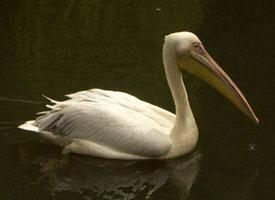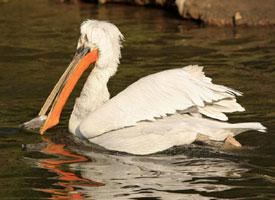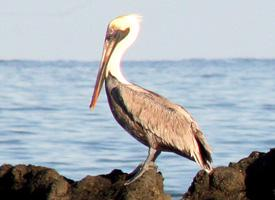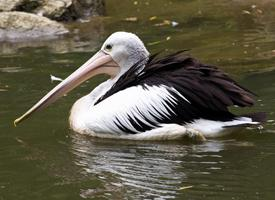
Cunoscut și ca
- Pelikán menší
- Pelikán obecný
- Pelikán růžový
Greutăți și măsuri
| Lungime | de la 148 la 175 cm |
|---|---|
| Greutate | de la 5 la 15 kg |
| Lungimea anvergurii aripilor | de la 226 la 630 cm |
Descrierea animalului
The Great White Pelican (Pelecanus onocrotalus) is a large bird that belongs to the pelican family, known for its distinctive appearance and behavior. This majestic bird is among the world's largest flying birds, characterized by its impressive size, with a length ranging from 140 to 180 cm (55 to 71 in) and a wingspan that can extend up to 2 to 3.6 meters (7 to 12 ft). The Great White Pelican is easily recognized by its predominantly white plumage, with shades of pink, grey, and black on the wings, and a distinctive large bill that is flat on top with a large throat pouch for draining water after scooping up fish.The bill is long and robust, measuring about 30 to 47 cm (12 to 18.5 in), and is equipped with a unique hook at the tip for gripping slippery prey. The throat pouch is not only an essential tool for feeding but also a striking feature during the breeding season when it turns a vivid pink color. The legs and webbed feet of the Great White Pelican are pinkish to grey, providing powerful propulsion in water.
Great White Pelicans are found in large, shallow freshwater lakes, marshes, and deltas in Africa, Europe, and Asia. They are highly sociable birds, often seen in flocks, and rely on cooperative feeding to catch fish. They work together to corral fish into shallow waters before scooping them up in their expansive bill pouches. Their diet mainly consists of fish, but they occasionally consume amphibians and small birds.
Breeding season brings about fascinating behaviors in Great White Pelicans. They nest in colonies, often on islands where they are safe from predators. Nests are built on the ground and are made from sticks, reeds, and feathers. Both parents are involved in incubating the eggs and feeding the young. The chicks are born altricial, meaning they are blind and featherless, completely dependent on their parents for food and protection.
The Great White Pelican has a graceful flight, characterized by powerful wing beats interspersed with gliding. These birds are capable of long-distance flights and are known to migrate seasonally between their breeding and wintering grounds. During flight, they often form impressive V-shaped formations, which is an energy-efficient way of traveling long distances.
Despite their widespread range, Great White Pelicans face threats from habitat destruction, pollution, and disturbance at breeding colonies. While they are not currently listed as endangered, their populations are affected by these human-induced factors. Conservation efforts are essential to ensure the survival of these remarkable birds, focusing on protecting their natural habitats and minimizing human disturbance.
In summary, the Great White Pelican is an awe-inspiring bird, notable for its size, social behavior, and unique feeding strategies. Its presence in the natural world highlights the importance of wetland ecosystems and the need for concerted conservation efforts to protect these environments and the myriad of life they support.
Animale similare
Fotografii noi cu animale
Top 10 animale
- Diana monkey (Cercopithecus diana)
- Dolphin gull (Leucophaeus scoresbii)
- Galápagos tortoise (Geochelone nigra complex)
- Moustached guenon (Cercopithecus cephus)
- Japanese spider crab (Macrocheira kaempferi)
- Colossal squid (Mesonychoteuthis hamiltoni)
- Fox tapeworm (Echinococcus multilocularis)
- Stone loach (Barbatula barbatula)
- Japanese macaque (Macaca fuscata)
- Barbary macaque (Macaca sylvanus)


